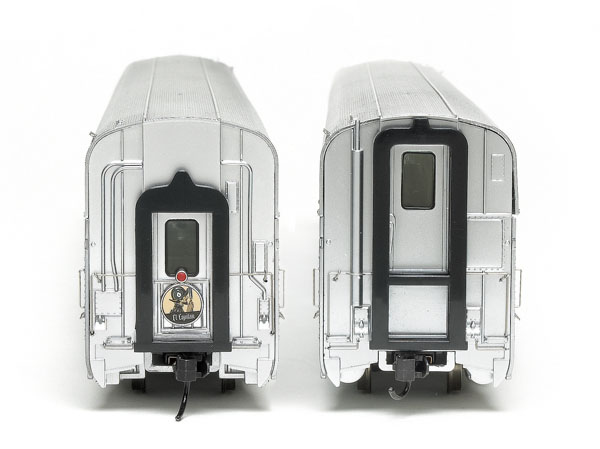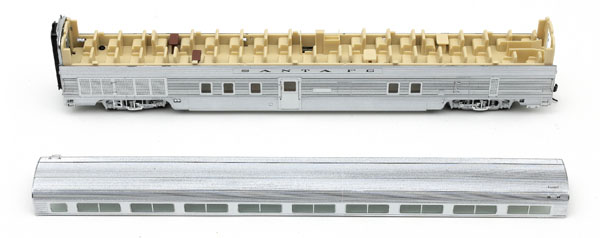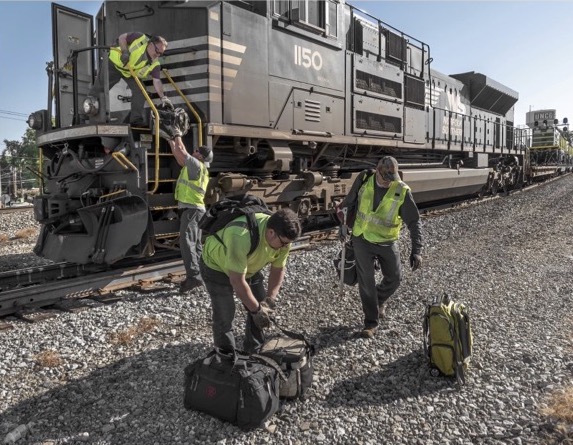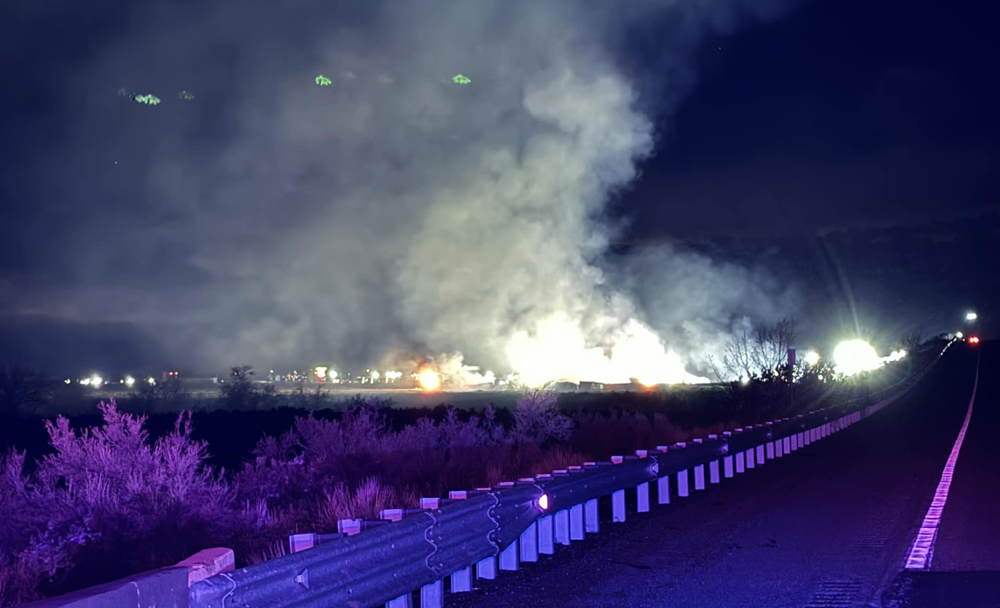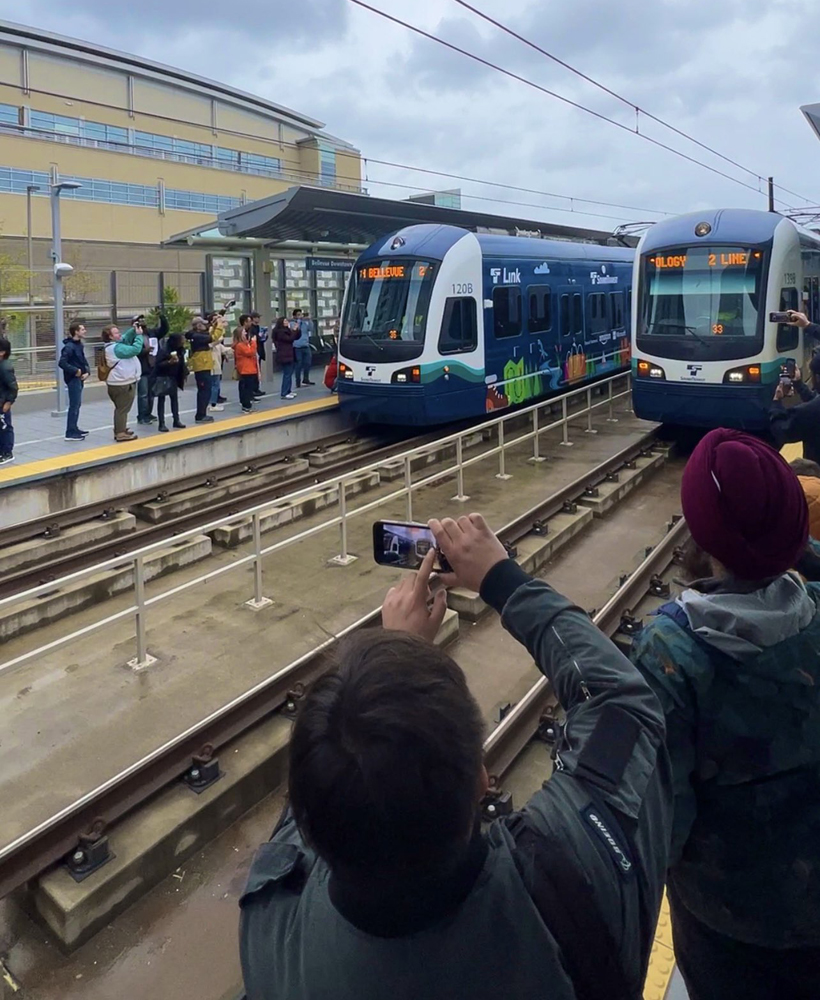Prototype. The El Capitan first ran in 1938 as a less expensive option to the railroad’s all-Pullman Super Chief. In 1956 the Santa Fe re-equipped its all-chair car El Capitan with new lightweight equipment. The Budd Co. supplied the railroad with Hi-Level cars that included coaches, diners, and lounges. With passenger compartment floors eight feet above the rails, the cars gave passengers a quieter ride and a better view of the scenery between Chicago and Los Angeles.
Depending on the car type, the top level was dedicated to passenger seating, a dining room, or lounge compartment. The lower level contained baggage, air conditioning, and other equipment. A kitchen occupied the diner’s lower level.
Step-down coaches had stairs at one end leading to a lower vestibule that matched standard-height cars. The “transition” baggage-dormitory car had a fairing on the rear of its roof to give the train a consistent look between the Hi-Level and standard height cars.
In 1958 Santa Fe combined the Super Chief and El Capitan consists, although the trains still ran separately during busy tourist seasons. The train ran until the formation of Amtrak in 1971. The Budd Hi-Level cars inspired Amtrak’s Superliner fleet, which still runs today.
The models of Budd-built prototypes match diagrams in The Passenger Car Library, Vol. 5. The baggage-dormitory transition car matches a diagram in The Official Pullman-Standard Library,
Vol. 1: Santa Fe. (Both books are published by RPC Publications.)
The baggage car and RPO use the same tooling as the models released several years ago for the Walthers Super Chief. The Hi-Level and baggage-dormitory transition cars are all-new tooling. All the cars feature a revised metallic finish meant to simulate the stainless steel sides of the prototype.
The carbodies are plated with a metallic silver finish. The plating is less shiny than the finish on the reissued Amtrak Superliner and Super Chief cars that Walthers released a few years ago. To my eyes, the finish on El Capitan looks more like in-service color photos of its prototype than the previous releases.
The plating seems to have adhered more readily to the smooth surfaces of the car. The finish on the closely spaced roof corrugations is slightly uneven.
The font and placement of the lettering and the color El Capitan tail sign on the last coach match prototype photos. Modelers must apply the car numbers using the supplied water-slide decals.
The corrugation pattern on each car is prototypical. The flush-fitting windows have a prototypical bluish tint.
All grab irons are factory-installed. The antenna on the baggage-dormitory is separately applied. The sprung plastic diaphragms of one car almost touch the next when the train is coupled.
Aside from the combined reservoir and the control valve, the Hi-Level cars don’t have any underbody detail. This didn’t bother me, though. From a trackside viewpoint, the underbody of the model is concealed by side skirting, as on the prototype. The baggage-dormitory transition car (as well as the baggage and RPO) have additional underbody detail parts that are visible from trackside, including water tanks, battery boxes, and air-conditioning equipment appropriate for each car type.
The metal truck sideframes have separately applied bolster anchors and swing hangers. The diner rides on correct three-axle trucks. The scale 36″ diameter wheels roll freely out of the box, but lubricating the axle ends is recommended in the instructions. This small step makes a noticeable difference.
All the metal wheels pick up track power. Walthers sells an interior lighting kit for the Hi-Level cars (no. 1055) that operates on direct current and Digital Command Control layouts. Set no. 1056 includes lighting for the tail sign.
On the Hi-Level cars, the roof and upper level side windows are one piece. I was impressed at how seamlessly this assembly fit into the car sides. However, getting inside the car to add figures or lighting requires a bit of work.
Following the instructions, I used the chisel blade to remove one end of the car. Then I carefully used the hobby knife to disengage the locking pins on both sides of the wall at that end. I could then lift off the roof and upper level window assembly, exposing the upper level interior. By removing five screws from the interior floor, I could lift off the upper level to reach the lower level interior.
The floor plans of the models matched those in prototype interior diagrams. The seats and walls are molded in a light tan color. Tables are separate pieces that are brown in the coaches and white in the diner and lounge.
Getting the cars open and back together took some patience, but hopefully that’s something modelers who wish to add figures and lighting will only have to do once. Overall the cars brought the El Capitan to life in HO scale, especially when we ran them behind a pair of warbonnet diesels.
Price: $79.98 each (Baggage-dormitory transition car is $74.98, baggage and RPO are $69.98 each)
Manufacturer
Wm. K. Walthers Inc.
P.O. Box 3039
Milwaukee, WI 53201
walthers.com
Era: 1956 to 1971 (as decorated)
Features
- Body-mounted Proto-Max magnetic knuckle couplers at correct height
- Minimum radius: 24″
- RP-25 contour metal wheels in gauge
- Weight: Hi-Level cars: 7.75 ounces (1 ounce too heavy according to NMRA RP-20.1)Baggage-dormitory transition car: 7 ounces (.25 ounce too heavy per NMRA RP-20.1)






